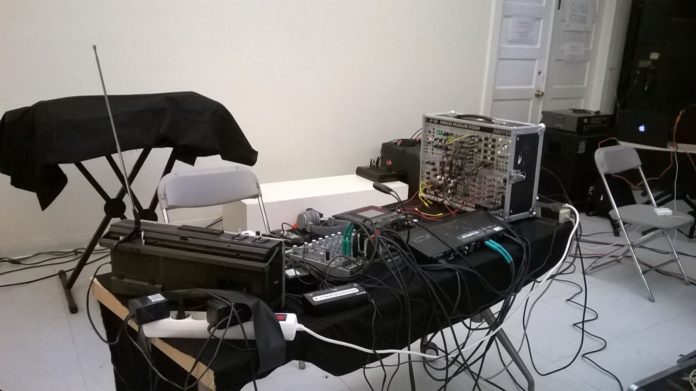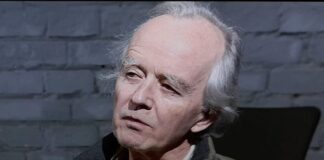The 2015 Sonic Circuits Festival of Experimental Music, the DC area’s fourteenth annual weekend-long program of experimental music and multimedia works, was held at the Pyramid Atlantic Art Center in Silver Spring, MD, the place that Sonic Circuits has called home for the past several years. Barring some unforeseen twist of events, this will be the last festival to be held at Pyramid’s Silver Spring building, which is scheduled to be vacated when Pyramid moves to a new building in Hyattsville, MD at the end of this year. No matter; the festival always does seem somehow to land on its feet.
As curated by organizer Jeff Surak, the lineup, as in previous years, was a well-balanced mix of local, national, and international artists. While electronics—sometimes quite heavy electronics–were central to a good number of sets, acoustic instruments—and moments of delicate interplay—made an appearance as well.
Friday, 18 September
Friday night’s opening set by DC area duo International Electromatics (Dave Vosh and Frank Vanneman, both on analogue modular synthesizers) inaugurated the festival with a tightly scaled set built around changes of density and dynamics on a surf of rising and falling long tones. Composer and electronic musician Dennis Kane, also from DC, followed with an electronic composition written for the occasion, a complexly textured piece of multiple, overlaid cyclical motifs of different lengths grounded in a slowly rising bass ostinato. Kane’s audio was paired with a video of similarly repeated cyclic images. Amsterdam’s Michel Banabila, who also made use of video projection—the second of three for the evening—leveraged a panoply of analogue synthesizer, radio and mixers into a textured piece constructed of a gradually accumulating collection of clicks, buzzes, static, and fragments of radio programs.
Following an intermission to clear the stage, Trumpet Trumpet Synthesizer—the Brooklyn-based duo of Brad Henkel on trumpet and electronics and Weston Minissali on synthesizer and vocals—offered oblique, post-pop song stylings that drew on a creative range of trumpet sounds, including a kind of unvoiced, quasi-Morse code rhythm and amplified air notes in duet with reverb. The set ended with the minute fluctuations of a breath-dependent, long-held tone. In contrast to this nearly dematerialized finale, DC area synthetist TL0741 (Pat Gillis) sculpted dark electronic sound masses into structures held together by high-tension dissonances balancing on multiple, but essentially stable, centers of gravity. The final set of the evening belonged to Los Angeles percussionist/sound artist Z’EV. In a performance dedicated to Jimi Hendrix on the 45thanniversary of his death—which happened to fall on this date—Z’EV mutated the audio and visual components of a glacially-slowed, brief extract from Hendrix’s 1967 performance at the Monterey Pop Festival while playing an electronically modified Guitar Hero drum kit. Although the set was plagued by projection problems, the concept survived intact.
Saturday, 19 September
In recent years the festival has included at least one free outdoor event to provoke and, it’s hoped, pique the interest of unsuspecting passersby. This year saw Surak’s Salarymen project, a duo with DC area sound artist Gary Rouzer that specializes in pop-up performances in public spaces, expand to include several more participants—myself included–distributed in pairs across downtown Silver Spring. As in previous years the notoriously changeable Mid-Atlantic weather somehow cooperated—are the weather gods partial to battery-operated electronics?—and so we took up our positions in the assigned spots. Playing everything from contact-miked objects to Dictaphones to acoustic percussion instruments to shortwave radios and amplified tablets, we gradually made our way to the Pyramid parking lot, where the full complement staged a twenty-minute improvisation of heterogeneous noises, supplemented by whatever ambient street sounds happened to show up. The good citizens of Silver Spring having been duly provoked and piqued, it was time for a couple of hours’ recess for the artists to regroup, eat, relax or soundcheck for what turned out to be a marathon evening session.
Back indoors, the Saturday evening program began with two sets by DC area artists. Nate Scheible opened, weaving a slow crescendo of loops from multiple tape players arranged in a semi-circle on the floor. Scheible was followed by the trio of Chris Videll (electronics), Jeff Barsky (electric guitar) and James Wolf (amplified violin), who played an atmospheric piece integrating microtonal drones and shards of chords and melodies moving between major and minor modalities. In an artfully accomplished change of ambience, Montrealer Anne-F. Jacques’s table of rotating and revolving amplified objects created gritty, almost tactile sounds moving with the regular rhythms of machinery.
It was to be a night of objects in fact, at times giving Pyramid the look and sound of a noisy Surrealist flea market of castoffs and readymades. Johannes Bergmark of Sweden, who followed Jacques, and the London pair of Clive Graham and Adam Bohman, who played later in the evening, rubbed, scraped, bowed, struck and otherwise cajoled pure timbres out of cutlery, toys, goblets, handtools and other bits of detritus. Graham and Bohman broke up their set with the wry humor of simultaneous readings of fragments of mundane and literary texts—restaurant menus, bits of fiction, automobile advertisements and the like. From Berlin, chanteuse/performance artist CoCo entranced the house with a compulsively charismatic set in which she sang, spoke, chanted, whispered, and simply exhaled to dramatic effect over a bed of live and recorded electronic sounds. Brooklyn experimentalist Bob Bellerue’s wall of loud, harsh noise followed.
BDM, the New York-based trio of percussionists Ben Bennett and David Grollman and saxophonist Michael Foster, and the always-unpredictable Prehistoric Horse—usually a trio, but tonight a duo of Grollman and cellist/performance artist Valerie Kuehne—performed two short, consecutive, and utterly cathartic sets of quite-possibly-controlled hysteria. Both groups worked with shock, outrageous humor, psychological provocation, frenzied playing and, in the case of Prehistoric Horse’s theater of mock cruelty, arresting visuals. For all its brevity, the experience was both bracing and refreshing.
Visuals of a different sort followed as Chester Hawkins (DC), working from two tables full of keyboards, effects and an analogue modular synthesizer, played a partly composed, partly improvised live soundtrack to a projection of the campy occultism of Kenneth Anger’s 1954 film Inauguration of the Pleasure Dome. Black Spirituals of Oakland, California, the duo of Zachary James Watson (electric guitar and electronics) and Marshall Trammell (drum kit), closed the evening—by now early morning—with a brief improvisation for themselves alone after which they were joined for a second piece by DC’s Ancestral Duo of Luke Stewart on electronics and Jamal Moore on saxophones.
Sunday, 20 September
This final evening of the festival—possibly the most eclectic in terms of the types of performances presented–began with DC area multimedia artist Mark Cooley, performing as Gut/Head. Cooley crafted a solo set in which he built up a multilayered, lushly diatonic piece out of looped kalimba, harmonica, and ebowed and finger-picked acoustic guitar.
Eva Zöllner of Hamburg, Germany, next performed two pieces composed for accordion and fixed media. The first, Nomadische Luftspiegelung by Finnish composer Antti Sakari Saaro, was an exquisite work forging overtones out of the massing of live and recorded accordion—it was often impossible to distinguish which was which. The second piece was an elaborately notated gestural work alternating deliberate spasms of tone clusters and rests. In the first of the evening’s two international collaborations Zöllner was joined by Gary Rouzer (DC) on cello and preparations and myself on double bass; we improvised a piece that explored nuances of timbre, harmony, and open space.
New York performance artist Jen Shyu next presented Solo Rites: Seven Breaths, a long dramatic work addressing cultural identity and tradition that combined multilingual songs sung to traditional Asian instruments, movement, storytelling and multimedia.
Guitarist Anthony Pirog and cellist Janel Leppin, both longtime participants in the DC area experimental music world, followed with back-to-back sets. Frequently performing together as Anthony and Janel, tonight they each focused on individual projects. (Although performing separately, Janel let slip a bit of joyfully received news at the end of her set—she and Anthony had just gotten back from the West Coast, where they’d been married.) Pirog, joined by Mark Cisneros and Ian McColm, played a tight, complex, high energy set of heavy, jazz-inflected, harmonically sophisticated instrumental rock for electric guitar and electric bass/tenor saxophone and drums. Leppin’s set consisted of a kind of cello suite updated for the 21st century, complete with opening prelude and several movements for cello and effects, electronics and voice. For a finale she performed an intimate folk-rock ballad, singing while accompanied by Anthony on acoustic guitar. The set that followed, a feedback-based noise performance by Portugal’s Rafael Toral, provided a dramatic contrast to Anthony and Janel’s duet.
The festival’s closing sets formed a kind of linked triptych courtesy of the local electric guitar ensemble Boat Burning and Austrian artist Mia Zabelka. In separate sets the six guitarists and single drummer of Boat Burning played rock- and Minimalist-rooted compositions by founder Andras Fekete and composer guitarist Jonathan Matis, while Zabelka, an artist of cosmopolitan background, presented work for electronic effects and processed electric violin. For the grand finale Zabelka and Boat Burning played a joint set.
With that, the 2015 Sonic Circuits Festival of Experimental Music ended. What happens next year is anyone’s guess, but next year is, in the world of Sonic Circuits, a very long time.










